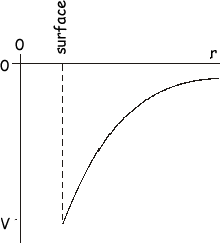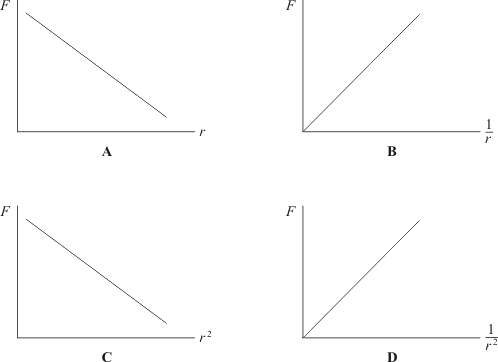Gravitational fields - Multiple Choice Q1 Masses of M and 2M exert a gravitational force F on each other when the distance between their centres is r. What is the gravitational force between masses of 2M and 4M when the distance between their centres is 4r?
Q2 A planet has a radius half the Earth's radius and a mass a quarter of the Earth's mass. What is the approximate gravitational field strength on the surface of the planet?
Q3. At the surface of the Earth the gravitational field strength is g, and the gravitational potential is V. The radius of the Earth is R. An object, whose weight on the surface of the Earth is W, is moved to a height 3R above the surface. Which line, A to D, in the table gives the weight of the object and the gravitational potential at this height?
Q4. A satellite of mass m travels in a circular orbit of radius r around a planet of mass M. Which one of the following expressions gives the angular speed of the satellite?
Q5. Which one of the following has different units to the other three?
Q6. The diagram shows two objects of equal mass m separated by a distance r.
Which line, A to D, in the table gives the correct values of the gravitational field strength and gravitational potential at the mid-point P between the two objects?
Q7. Mars has a diameter approximately 0.5 that of the Earth, and a mass of 0.1 that of the Earth.
If the gravitational potential at the Earth’s surface is –63 MJ kg–1, what is the approximate value of the gravitational potential at the surface of Mars?
Q8. A small mass is situated at a point on a line joining two large masses ml and m2 such that it experiences no resultant gravitational force. If its distance from the mass m1 is r1 and its distance from the mass m2 is r2, what is the value of the ratio ?
Q9. A projectile moves in a gravitational field. Which one of the following is a correct statement for the gravitational force acting on the projectile?
Q10. The diagram shows two positions, X and Y, at different heights on the surface of the Earth.
Which line, A to D, in the table gives correct comparisons at X and Y for gravitational potential and angular velocity?
Q11. When at the surface of the Earth, a satellite has weight W and gravitational potential energy –U. It is projected into a circular orbit whose radius is equal to twice the radius of the Earth. Which line, A to D, in the table shows correctly what happens to the weight of the satellite and to its gravitational potential energy?
Q12. The graph shows how the gravitational potential, V, varies with the distance, r , from the centre of the Earth.
What does the gradient of the graph at any point represent?
Q13. Near the surface of a planet the gravitational field strength is uniform and for two points, 10 m apart vertically, the gravitational potential difference is 3 J kg–1. How much work must be done in raising a mass of 4 kg vertically through 5 m?
Q14. What would the period of rotation of the Earth need to be if objects at the equator were to appear weightless?
Q15. The Earth has density ρ and radius R. The gravitational field strength at the surface is g. What is the gravitational field strength at the surface of a planet of density 2ρ and radius 2R?
Q16. Which one of the following graphs correctly shows the relationship between the gravitational force, F, between two masses and their separation r
Q19. A planet of mass M and radius R rotates so rapidly that loose material at the equator only just remains on the surface. What is the period of rotation of the planet?
Q20. As a comet orbits the Sun the distance between the comet and the Sun continually changes. As the comet moves towards the Sun this distance reaches a minimum value. Which one of the following statements is incorrect as the comet approaches this minimum distance?
Q21. Which one of the following statements about Newton's law of gravitation is correct? Newton's law of gravitation explains
Q22. If an electron and proton are separated by a distance of 5 × 10–11m, what is the approximate gravitational force of attraction between them?
Q23.A spherical planet of uniform density ρ has radius R. Which line, A to D, in the table gives correct expressions for the mass of the planet and the gravitational field strength at its surface?
Q24.
|
Follow me...
|










